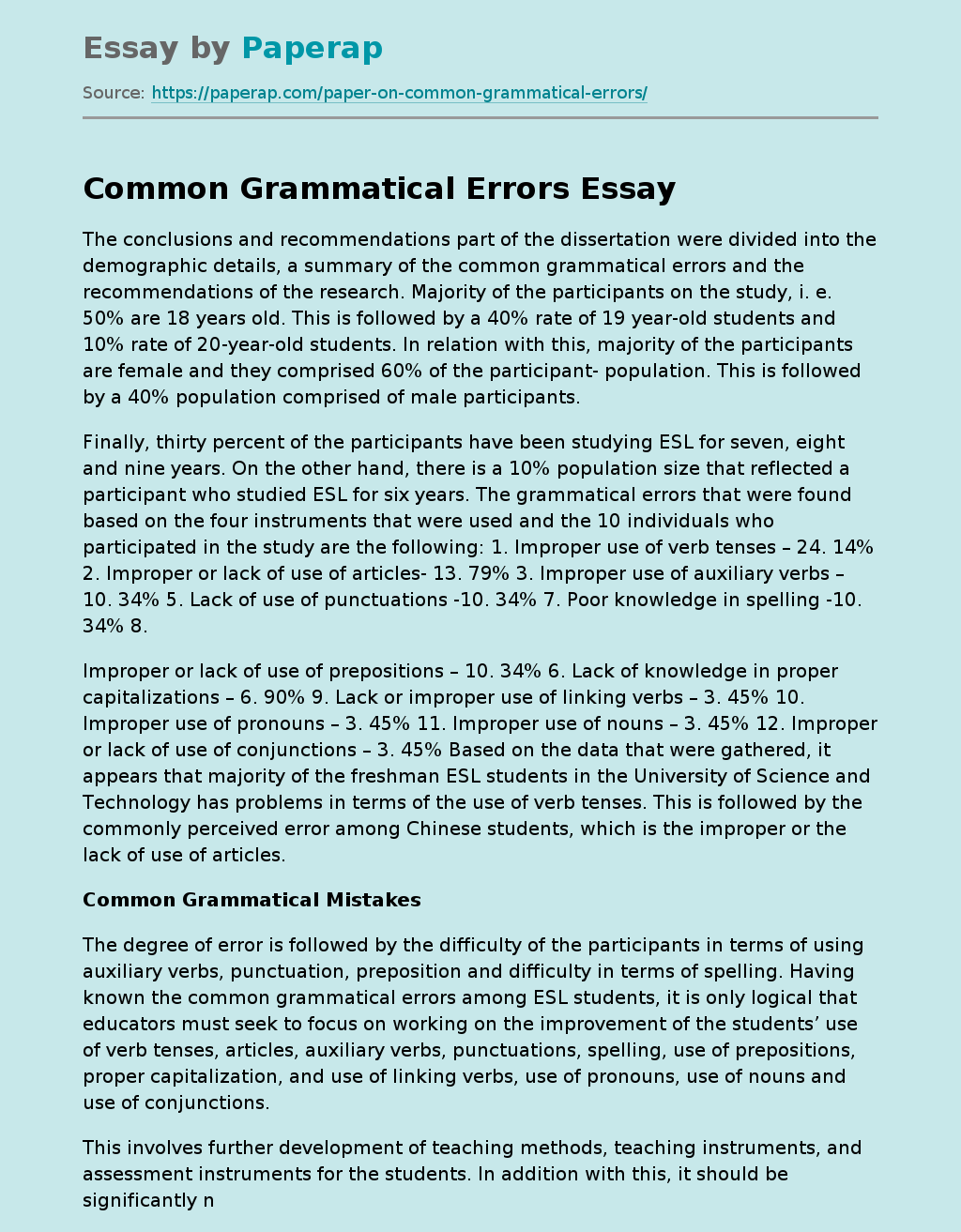Common Grammatical Errors
The conclusions and recommendations part of the dissertation were divided into the demographic details, a summary of the common grammatical errors and the recommendations of the research. Majority of the participants on the study, i. e. 50% are 18 years old. This is followed by a 40% rate of 19 year-old students and 10% rate of 20-year-old students. In relation with this, majority of the participants are female and they comprised 60% of the participant- population. This is followed by a 40% population comprised of male participants.
Finally, thirty percent of the participants have been studying ESL for seven, eight and nine years.
On the other hand, there is a 10% population size that reflected a participant who studied ESL for six years. The grammatical errors that were found based on the four instruments that were used and the 10 individuals who participated in the study are the following: 1. Improper use of verb tenses – 24. 14% 2. Improper or lack of use of articles- 13. 79% 3. Improper use of auxiliary verbs – 10. 34% 5. Lack of use of punctuations -10.
34% 7. Poor knowledge in spelling -10. 34% 8.
Improper or lack of use of prepositions – 10. 34% 6. Lack of knowledge in proper capitalizations – 6. 90% 9. Lack or improper use of linking verbs – 3. 45% 10. Improper use of pronouns – 3. 45% 11. Improper use of nouns – 3. 45% 12. Improper or lack of use of conjunctions – 3. 45% Based on the data that were gathered, it appears that majority of the freshman ESL students in the University of Science and Technology has problems in terms of the use of verb tenses. This is followed by the commonly perceived error among Chinese students, which is the improper or the lack of use of articles.
Common Grammatical Mistakes
The degree of error is followed by the difficulty of the participants in terms of using auxiliary verbs, punctuation, preposition and difficulty in terms of spelling. Having known the common grammatical errors among ESL students, it is only logical that educators must seek to focus on working on the improvement of the students’ use of verb tenses, articles, auxiliary verbs, punctuations, spelling, use of prepositions, proper capitalization, and use of linking verbs, use of pronouns, use of nouns and use of conjunctions.
This involves further development of teaching methods, teaching instruments, and assessment instruments for the students. In addition with this, it should be significantly noted as well that the writing process is very relevant, the student’s writing ideas should also be paid close attention. It is evident from the primary data that there has been a significant degree of problem in terms of the morphosyntactic or lexical accuracy of the participants’ sentences.
As such, effective English grammar could be instilled upon students by having the aforementioned explore their thoughts and ideas. It is often the case that since the process of teaching grammar to ESL students can be tedious, difficult and frustrating at times; some instructors tend to overlook the relevance of the creativity and freedom of expression (Ferris, 1998, p. 198). The notion of teacher’s feedback is also relevant most specially in terms of correcting grammatical errors among students.
More often, students rely heavily on what their teachers would say in order to correct the errors in their compositions (Ferris, 1998, p. 199). However, most recent studies suggest that although students primarily believed on the notion of correction, it does not necessarily follow that teachers should be giving it to them at all times. It is argued by researches of Truscott (1996, p. 360) that error correction appears to be not at all effective in terms of improving grammatical accuracy.
Rather, educators must focus instead of making their students self-sufficient in terms of editing their own work. According to Truscott (1996), the absence of any feedback or strategy among students after their education in any ESL institution would only instill the lack of seriousness to improve their editing or writing skills (Ferris, 1998, p. 200).
As such, Truscott (1996) said: “Veteran teachers know that there is little direct connection between correction and learning. Often a student will repeat the same mistake over and over again, even after being corrected many times. When this occurs, it is tempting for the teacher to say the student is not attentive or lazy; however, the pervasiveness of the phenomenon, even with successful students, argues against any such explanation.
Rather the teacher should conclude that correction simply is not effective”. (p. 341) As such, for the purpose of this research, the author seeks to recommend a balance among grammar accuracy on students by effectively aligning teaching strategies to be in accordance with the foremost needs of the students; allowing students to be more creative and explore their thougths; and instilling a good theoretical and practical foundation of the fundamentals of English grammar.
Bibliography
Alderson J. C. ( 1984). “Reading in a foreign language: A reading problem or a language problem? ” In J. Alderson & A. Urquhart (Eds. ), Reading in a foreign language (pp. 1-27). New York: Longman. Alderson J. C. , Clapham C. , & Wall D. ( 1995). Language test construction and evaluation. Cambridge, England: Cambridge University Press.
Common Grammatical Errors. (2019, Dec 05). Retrieved from https://paperap.com/paper-on-common-grammatical-errors/

